Are You A Vanguard? Applications Now Open
This is your first of three free stories this month. Become a free or sustaining member to read unlimited articles, webinars and ebooks.
Become A MemberIt would be wrong to say Aquil Bickerstaff was destined to end up dead or in prison. But like all black men of his generation, the odds were stacked against him.
When he was born in 1985, to a working-class family in North Philadelphia, he entered a world that was becoming increasingly hostile to him.
The decade had begun with a recession that wiped out nearly three million jobs in just three years. A large number were unionized factory jobs held by African-Americans. As steady sources of income became scarcer in areas like North Philadelphia, mortgages went unpaid and businesses closed their doors.
By 1983, North Philadelphia was home to a third of the city’s 65,350 vacant properties. A New York Times reporter observed a city growing “poorer and more segregated.”
Meanwhile, things were about to get worse. As the black working class was grappling with the hand it had been dealt by the recession, it was also getting hit on two other fronts. Welfare cuts enacted by Congress in 1981 eliminated cash assistance for roughly 20 percent of eligible American families and cut food stamp benefits for more than 2 million people. Almost on cue, crack cocaine began spilling into urban neighborhoods, providing both a respite from despair and a robust new source of income for men and women low on options. As drug dealers took over blighted corners and empty houses, Philadelphia’s homicide rate surged, with 20 percent of Philadelphia killings between 1985 and 1988 attributed to the drug trade.
Congress responded to the bloodshed by enacting some of the toughest anti-crime measures in more than a decade, with new laws eliminating parole for federal prisoners, singling out drug traffickers for enhanced sentencing if they were carrying a firearm, and creating new mandatory minimums for drug crimes. These efforts culminated with the passage of the Anti-Drug Abuse Act of 1986, which established the racially biased “crack disparity” that levied higher penalties for possession of cocaine base.
It was as if a perfect storm had descended on Black America, and the house that four generations of Bickerstaff’s extended family called home sat directly in the eye of it.
Data science offers a rough sketch of the unique demographic boundaries of this tempest.
We know, for instance, that when he was gunned down on a Philadelphia street at the age of 28 in early 2014, Bickerstaff was six times more likely to meet that violent end than a white man the same age, and that his shooter, Rashaun Peterson — who was sentenced to life without parole in May — was statistically more likely to commit the crime at 21 than he will be at 26.
At the time of their encounter, both men had already cashed in on their roughly one-in-four chance of winding up in jail at some point in their lives. And given their prior experience with the criminal justice system, the odds were better than a coin toss they’d be locked up again in the future.
Many, if not most, Americans will never possess more insight into the lives and deaths of these two men, or others like them, than is provided by this crude statistical portrait.
On the cold January evening that Bickerstaff was killed, less than two weeks had passed since the start of the new year and Philadelphia police had already responded to 31 shootings, nine of them fatal. His murder barely registered a blip on the radar of a city that experiences, on average, 300 homicides a year. Peterson’s arrest for the crime five months later managed to garner two short paragraphs of copy in the local press, but not a single word was printed the day he walked into prison for the rest of his life, barely old enough to legally drink.
These two men are now counted among the 36,000 black men who one data scientist has estimated are missing from Philadelphia’s communities as a result of incarceration or early death. Yet this data point is meaningless when measured against the trauma their disappearance has inflicted on the people closest to them — not least of all the four young children who have been left behind to grow up fatherless.
Nearly two years after his death, Bickerstaff’s mother, Lisa, still can’t look at a picture of him. She declined an invitation to talk about her son, explaining through a family intermediary that the topic is still too painful to revisit.
His sister, Laisha McDuffie, who is now 33, took to Facebook following his murder to publicly express the depth of her loss. A posting from February 3, 2014 — just days after his funeral — provides a snapshot of her pain:
“Up thinking about my brother I keep thinking I’m a ride pass the block and see him he’ll get smart I’ll laugh and call him dirty then he’ll try to put me in a head lock my brother I need him so bad I can hear him I see him in my dreams every night I miss you I need you Q.”
Her words, while highly personal, reflect an experience shared by a disproportionate number of African-American families of a certain time and place. The trajectory of their grief leads back to an America in the midst of a protracted period of urban decline that was about to experience an unprecedented surge in income inequality and violent crime, and the highest rates of joblessness since the Great Depression. In the following two decades, efforts to deal with their combined impact would fuel the birth of the most voracious prison system in the world, and it would consume not only Aquil Bickerstaff, but also an entire male generation of his extended family.
_591_452_80.JPG)
Aquil Bickerstaff, left, and his cousin Clarence Smith, right, in a 2012 photo. (Photo courtesy of Clarence Smith)
Exploring how that happened might just offer some clues for preventing their progeny — including Bickerstaff’s seven-year-old namesake — from suffering the same fate.
The 2700 block of North Taylor Street, where Bickerstaff grew up, is located in one of Philadelphia’s most socioeconomically marginalized communities. Known as Allegheny West, it was once a vibrant industrial center. Today, dozens of empty factories border trash-strewn thoroughfares that once carried hundreds of local workers to jobs making everything from wrapping paper to machine tools.
The community is more than 99 percent African-American and nearly 40 percent of residents live below the poverty line. It is considered a million dollar block — a phrase that refers to the $1 million taxpayers shell out each year to incarcerate residents of a single census block.
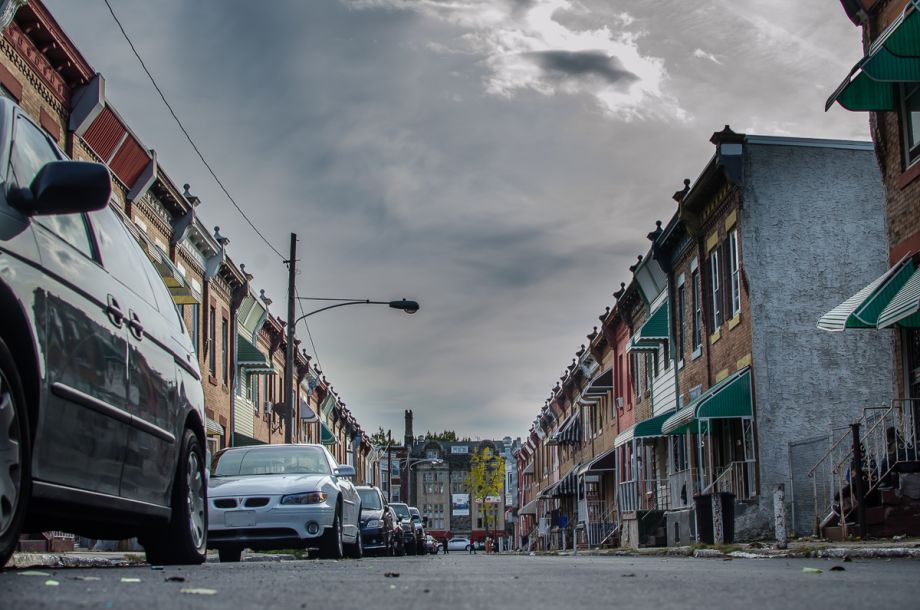
The 2700 block of North Taylor, where five generations of the McDuffie family have lived
Donald Haywood is 51 and has spent his entire life as a resident of Allegheny West. He now shares a home on North Taylor Street with his companion, Elanor Mathis. Haywood grew up around the corner and remembers the neighborhood of his youth as a community of hardworking, mostly two-parent families where kids could play safely in the street until 11 at night and most residents left doors unlocked. He said the neighborhood began to decline in the late 1970s with deindustrialization, and that by 1983, after three years of crippling recession, it was no longer safe to walk the streets.
“A lot of factories around here started to close down and that left a lot of people struggling for a way to survive,” he says. “Some people turned to welfare, other people turned to crime and drug dealing.”
Haywood, who is now retired, says he managed to maintain semi-regular employment as a contractor.
“I mostly just minded my own businesses,” he says. “That drug game will get you killed.”
This was the environment Bickerstaff’s aunt Emma Godwin encountered when she moved onto the street in 1980, occupying a house on the north end of the block.
“It used to be you couldn’t walk too far out of the neighborhood where you didn’t know anyone or you might get victimized,” says Godwin.
Her parents, Emma and George McDuffie, soon joined her. They bought the house in 1990 for $5,000. At various times over the years all seven of Godwin’s siblings have taken up residence there; the house has been the center of McDuffie family life for three decades.
By the time Godwin gave birth to her youngest, Clarence Smith, in 1983, the neighborhood was already a hotbed of drug activity run by local crews that fiercely defended their turf.
Then, like now, the majority of non-drug crimes were economically motivated. Robbery and assault were common, and even the police weren’t immune to the lure of quick cash. In 1995, members of a narcotics team known as the Five Squad were convicted of engaging in widespread corruption, including shaking down local dealers and making false arrests.
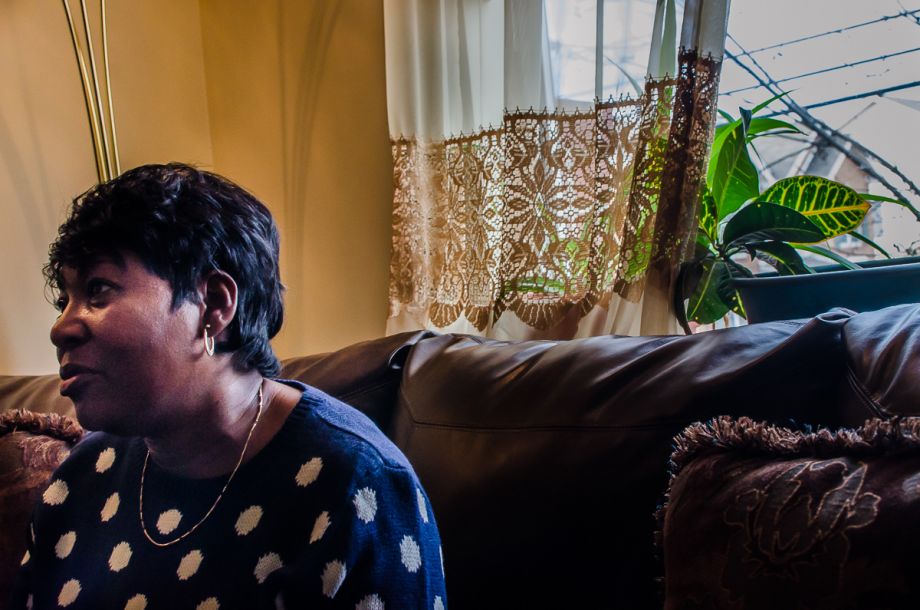
Emma Godwin in her North Philadelphia home
Godwin says her most pressing concern as the mother of young children was the deadly culture of bravado that took hold with the arrival of crack cocaine and changed the way conflicts were settled.
“When we were young you might get into a fight and throw a few punches and then you let it go,” she says. “But these boys settled things with a gun.”
She moved her son out of Allegheny West around 1986, eventually settling in the less fraught Lawncrest section of Northeast Philadelphia. By then, her siblings had kids of their own. Her brother’s son Tyrone McDuffie, born in 1986, is the youngest. Behind him, in order of age, are Aquil Bickerstaff, Phillip McDuffie, Jonathan Jacobs, Phillip’s brother, who was shot and killed in 2003 at the age of 19, and George McDuffie. (Clarence is the oldest.) One by one, each of them would enter into the custody of state or federal correctional authorities before they turned 21, for crimes ranging from drug possession to attempted murder.
For some families, crime and incarceration are hereditary conditions that afflict multiple generations. But for many more, including the McDuffies, the cycle of drugs, violence and prison is a recent phenomenon that disrupted long-standing traditions of hard work and self-sufficiency.
The family patriarch, George, who died in 1994, had faced a judge only once, on a 1971 drunk driving charge. Godwin is closely involved with her church and says none of her siblings have been in trouble with the law. Bickerstaff’s father worked for the city sanitation department. He died of natural causes when his son was 10.
Clarence Smith’s father — who was killed in a freak accident in 1985 while working for Coca-Cola — didn’t have a record. His mother, who remarried and then divorced, was hyper-attentive to the challenges her son and his two older siblings faced growing up.
“When I left the house for work, my kids were expected to be in the house, not hanging on the corner,” Godwin says. “I always checked their room and listened to phone calls. If they didn’t seem right I was going to find out what it was.”
Smith immersed himself in sports while a student at Frankford High School and ranked in the top three citywide for wrestling two years in a row. Even so, he found it hard to resist the cultural and economic pressures he encountered in North Philadelphia, where corner hustling is a right of passage for many boys.
“It’s easier to sell drugs than get a job for a 16 year old,” says Smith.
That statement was even more true at the start of the millennium, when the first of the McDuffie cousins were just entering adulthood. The nation was in the throes of its third economic recession in 20 years and the jobless rate for black teenagers surpassed 40 percent.
Young black men in places like Allegheny West looked around them and saw limited options.
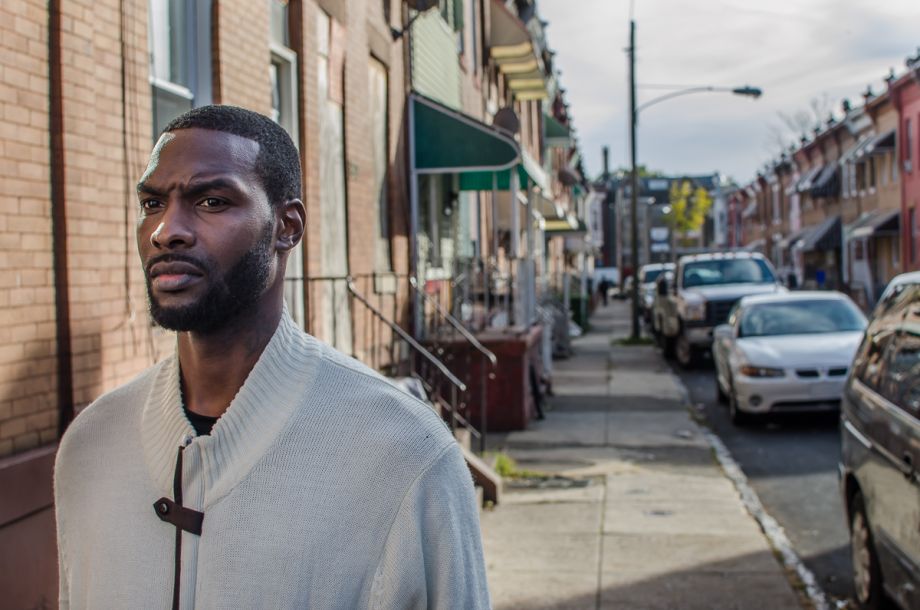
Clarence Smith, 32, in front of his childhood home on the 2700 block of North Taylor Street, in Philadelphia
Smith briefly tried his hand at street dealing as a teenager, but found it monotonous. He secretly had bigger ambitions.
“I wanted to be a distributor,” he says.
He was hardly alone. In June 2001, when Smith became the only one of his male cousins to graduate high school, two of his cousins — George and Phillip — were already immersed in the North Philadelphia drug trade and were fighting their first felony cases. Sensing an opportunity to avoid the same fate, Smith enlisted in the Army and was sent to Fort Sill in Oklahoma for basic training. But even five states and 1,400 miles away, he still managed to keep one foot on North Taylor Street.
In the weeks following September 11th — as the first U.S. ground troops were entering Afghanistan — Smith was busy turning a small settlement he received at 18 from his father’s death into a multi-state marijuana distribution business.
“I learned how to sell drugs in the Army,” he says. By the end of 2002 he had netted more than $100,000 shuttling pounds of pot by car across the country to Bickerstaff in Philadelphia. There it was broken up for retail sale by a crew of dealers who operated for a time from a house at the corner of Lehigh and Taylor streets.
Smith was honorably discharged from the Army for an injury in 2003, just as his brief run as a drug kingpin was coming to a close. That fall, a drug- and alcohol-fueled ride in Smith’s ’98 Cadillac S ended with he and Bickerstaff exchanging gunfire with a group of men they encountered in Northeast Philadelphia. No one was injured in the melee, but both he and his cousin faced charges of attempted murder and aggravated assault that carried a possible 50 to 100 years in prison.
Two days earlier, his cousin Phillip McDuffie had been picked up on drug charges a few blocks from the family home on North Taylor. He was awaiting trial at Curran-Fromhold Correctional Facility in Philadelphia when Smith came through processing.
“I was happy for him when he went in the Army,” says Phillip. “I was shocked when I saw him come through jail. I mean I knew about the drug thing, but for something like that?”
It was an unseasonably warm day in September when I met Phillip outside the house on North Taylor Street. His 10-year-old son, Semaj, and daughter Samideya, who is three, played on the street in front of him. Phillip, who is 31, is soft-spoken and shy. A three-inch scar cuts across the side of his head where a bullet grazed him during an attempted robbery when he was 16. He had been trying to steal the gun when he was shot. He says he remembers standing on a neighborhood street corner delirious and bleeding, refusing to walk the half a block to his grandmother’s house.
“In our family we’re taught respect,” he says. “Whatever we did in the street, we didn’t bring it home.”
Phillip dropped out of William Penn High School soon after that incident and devoted himself full time to the drug trade. Three years later, a drug rival fatally shot his brother Jonathan on the same block where he had been shot. No one was ever arrested for the murder.
Phillip lives in Philadelphia’s Germantown section now, but he still spends a lot of time in his old neighborhood. Everyone who walks by seems to know him.
“These streets were all I knew,” he says, and lifts his sleeve to reveal the word “Somerset,” the name of the North Philadelphia street where he grew up, tattooed on his forearm. “When I walked out the door, everyone I knew was hustling.”
Phillip was 18 when he and Smith crossed paths at CFCF and he was facing his third felony case. Five more arrests would follow before he turned 21. In each of those cases the charges, which included robbery, aggravated assault and drug distribution, were ultimately dismissed or dropped.
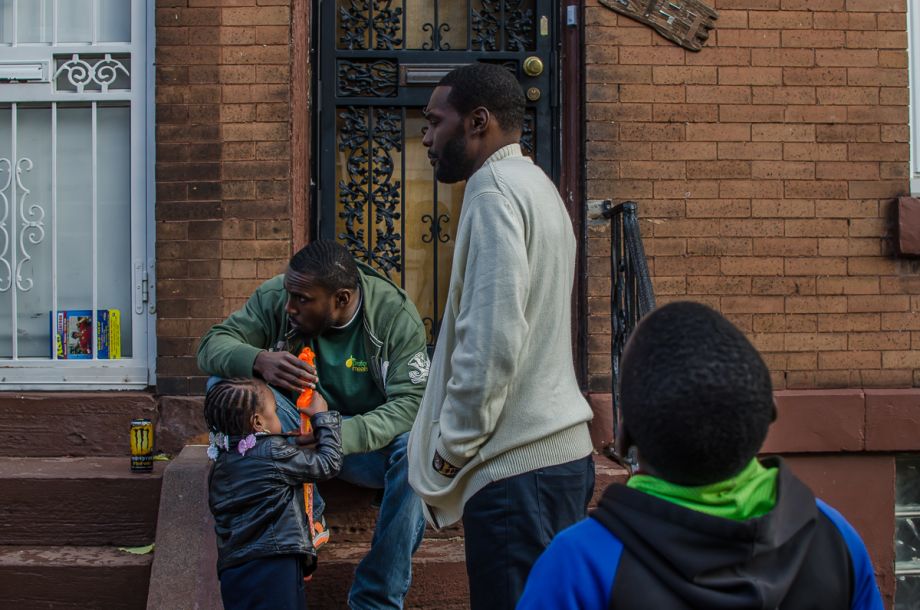
Clarence Smith and Phillip McDuffie play with McDuffie’s children Semaj, 10, and Samideya, 3, on a North Taylor Street stoop.
“It was like a revolving door,” he says, describing going in and out of the Philadelphia jail system four times in a single year.
That door slammed shut in April 2005 when Philadelphia police arrested him on a bench warrant for failing to appear in court. At the time he was carrying a loaded .357 Magnum and nearly five grams of crack cocaine bagged up for sale. Two of the six shells in the firearm were spent, indicating the gun had been fired.
He pleaded guilty to a federal charge of carrying a firearm in furtherance of a drug trafficking crime and was sentenced to eight-and-a-half years in federal prison. He spent most of his time far from his family in correctional facilities in Kentucky and Virginia. His sentence was reduced to 90 months in 2008, after the U.S. Sentencing Commission retroactively eliminated the “crack disparity” Congress enacted in 1986.
The year Phillip entered the federal prison system, Smith and Bickerstaff were beginning their second year of confinement with the Pennsylvania Department of Corrections. Both had accepted plea deals and were given sentences of four to eight years.
Smith’s girlfriend was pregnant when he was arrested, and she gave birth to a son, Ramaj, while he was in county jail awaiting trial. He got to spend time with him briefly after posting bail, but didn’t see him again until after he was released from the State Correctional Institution at Camp Hill near Harrisburg in 2008. Ramaj is now 12 and lives with his mother in Oklahoma.
“You can’t be a full-time parent being incarcerated,” Smith says. “I was able to take care of my son financially but only because I had made so much money selling drugs before I went away.”
The high cost of maintaining contact with inmates puts more than one in three families with incarcerated members into debt to pay for phone calls and visits alone, according to the Ella Baker Center for Human Rights.
Recently, the Federal Trade Commission began investigating price gouging by telecommunications providers that service correctional facilities.
Smith says he ate through $25,000 while in prison, reentering society with a negative balance on his bank account. By then he had made the decision that he would not pick up where he left off. He has worked a series of jobs since his release, but he says his progress has been slow and fraught with obstacles. He lost a number of fruitful employment opportunities due to his felony record.
“I wanted to give up,” he says. “There were too many doors being closed because of my conviction. They didn’t care that I was a veteran. They didn’t care that I had a family I had to support. The only thing they looked at was my record.”
Reentry professionals say getting a job is the biggest challenge most inmates will encounter when they are released. Those who fail to do so are significantly more likely to reoffend.
“The single-most important thing a person needs when they leave prison is a job, and there just isn’t enough stable employment out there,” says Jason Cosley, who oversees the prisoner reentry program at Impact Services Corporation in Philadelphia. “We see guys who have been out one or two years who still don’t have a stable job.”
Smith now works at an appliance store in the city and finds inspiration working as a mentor for ex-offenders with a grassroots organization called the Elevation Project.
His cousin would never reach that level of stability. Bickerstaff earned his GED while in prison, but struggled to gain footing after his release in 2007. At the time of his death Bickerstaff was working part time as a barber and operating a food service business, while continuing to sell drugs on the side.
Police attributed his murder to “an argument,” but people who knew him say his death was the result of an ongoing conflict, possibly involving drug sales, that began when the victim moved to Rashaun Peterson’s neighborhood from North Philadelphia. Smith says he was set up by acquaintances who were jealous of his financial success.
At the time of his death, in 2014, Bickerstaff’s family had already suffered its share of tragedy. Two years earlier, his eldest sister, Lakisha Jackson, had been murdered at her home in Salisbury, Maryland, by the estranged boyfriend of her 17-year-old daughter. Bickerstaff’s two nieces, one of whom was pregnant, were critically injured in the attack. The assailant, who was just 19 at the time of the crime, was sentenced in 2013 to life without parole.
Laisha McDuffie, says that losing her brother was a serious blow to the family, which was only beginning to come to terms with his sister’s death.
“Aquil was the kind of guy that if you were having the worst day, his presence, his smile would make you feel like the world was a perfect place. I miss him so much sometimes,” she says. “I hide my feelings because I don’t want to upset my mother, but inside I’m dying every day, on the verge of tears.”
Over the course of their lives, the six McDuffie cousins born between 1983 and 1986 have come to represent a narrative that is all too common of men of their generation.
Of the four who are still living, two — George and Tyrone — are currently awaiting trial on felony charges. After his release from prison in 2012, Phillip McDuffie managed to get a low-paying job at a scrapyard, but soon lost it due to cutbacks. In April he faced a parole revocation hearing — for smoking marijuana — that nearly ended in house arrest. According to court documents, he told his parole officer he started getting high because he was “stressed out,” which, given the precariousness of his future, was probably an understatement.
He says his greatest challenge, though, has been learning to be a father to his son Semaj, who had just turned one when Phillip went away and saw his father just once in four years.
“When I came home my son was seven,” says Phillip. “I had missed years of his life and now here I am living under the same roof with him, supposed to be a father to a boy who hardly knew me.”
He says it’s been humbling to have to deny his son material comforts that he easily could have provided in his old life. When I ask him what keeps him from giving up and going back to that life, he points again to Semaj.
“When I walked out on the street I saw alcoholics, addicts and drugs dealers, and I knew I didn’t want to be an addict or an alcoholic,” he says. “I don’t want my son to face that same choice.”
Those streets have improved considerably since Emma Godwin moved onto North Taylor. The drug trade is less visible. And the five homicides the area has experienced over the past six months is a fraction of the murders the community saw in the 1980s and 1990s.
In 2005, a brand-new library branch opened, replacing a facility that had fallen into disrepair. And since 2012 the neighborhood has been a target for revitalization under the city’s PhillyRising program.
But Allegheny West continues to be plagued by problems. Poverty is endemic and unemployment is twice the city average.
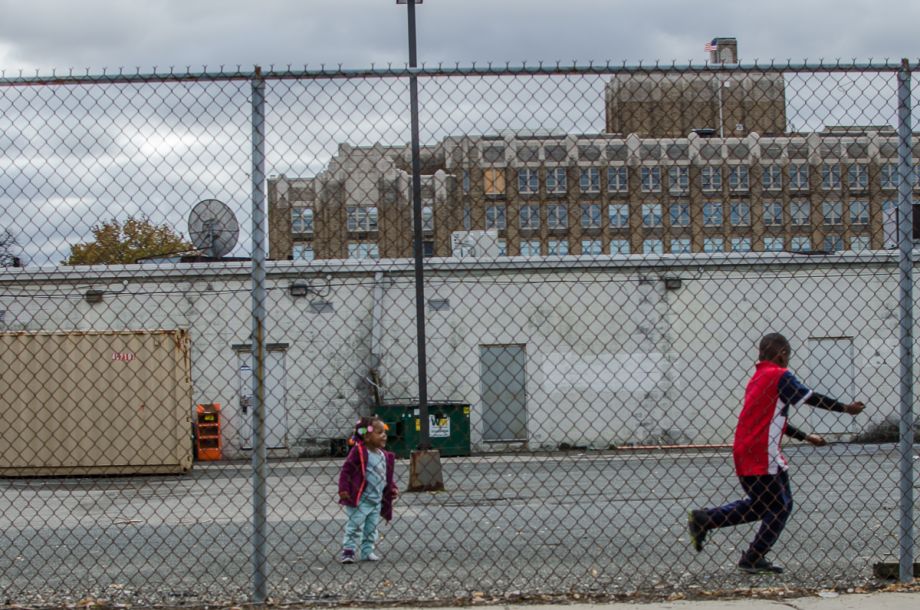
Two children spend an afternoon playing in the abandoned parking lot of a defunct factory near North Taylor Street.
In sheer numbers, the 19132 zip code still accounted for the third highest number of Philadelphians (815) serving state time in 2014, according to Department of Corrections data. It remains a virtual recycling center for the DOC, with roughly 300 people going into the system and 300 coming out each year. Hundreds more flow in and out of Philadelphia’s six municipal jails or are monitored by the commonwealth or county under supervised release programs.
The year that Clarence Smith left Camp Hill, the state spent $40 million to lock up individuals from the 19132 zip code that includes North Taylor Street, an amount rivaling that spent per capita on education.
Laisha McDuffie says that some days her brother Aquil’s absence is so acute it’s like reliving the moment she was told he’d been killed.
“I really don’t think any of us will ever recover fully, or even at all,” she says. “When I look into his children’s faces it breaks my heart all over again.”
She remains closely involved in the lives of her nieces and nephew, but worries about what their future might look like.
“I worry about all three of his children all the time, especially Aquil Jr.,” she says.
Her fears are well founded. The storm that engulfed her brother is already beginning to consume the next generation of young McDuffie men.
Her nephew, Matthew Baldwin — the son of Phillip McDuffie’s sister, Anishia — grew up on North Taylor Street, and was living there in 2012 when he fatally shot 18-year-old Kharee Tillmon on a crowded playground in North Philadelphia. He was 17 at the time, and had lost his own father, Matthew Sr., to a bullet in 2004. Last January, Baldwin was sentenced to 50 years to life.
Cosley, at Impact Services Corporation, attributes the vicious cycle to a confluence of factors, including high poverty rates, high crime and the large number of returning inmates concentrated in areas that are unable to provide support for them.
“You take the combination of all these factors and that’s a recipe for distressed neighborhoods,” he says.
Smith acknowledges those factors, and the role they played in creating the uneven playing field that funneled him from boot camp in Oklahoma to a jail cell in Pennsylvania. But like most other people I spoke to for this story, he is unwilling to see himself as simply a cog in a machine he has no power to stop. To accept otherwise would be to invalidate the obstacles he has overcome, against the odds, to avoid the fate that so many others in his family have been unable to outrun.
“I made it up in my mind,” he says. “I did not want to become a statistic.”
Our features are made possible with generous support from The Ford Foundation.
Christopher Moraff writes on politics, civil liberties and criminal justice policy for a number of media outlets. He is a reporting fellow at John Jay College of Criminal Justice and a frequent contributor to Next City and The Daily Beast.
Follow Christopher .(JavaScript must be enabled to view this email address)
Joshua Scott Albert is a Philadelphia-based photographer and reporter. He's contributed to VICE, Buzzfeed, Philadelphia Magazine and several other outlets.

20th Anniversary Solutions of the Year magazine